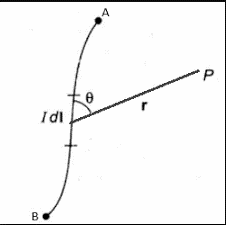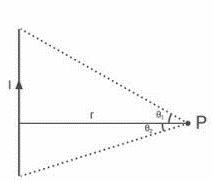Faraday’s law formulaThe formula for Faraday’s law are as stated below | ||
Description | Formula | |
Faraday’s first law | The first law of Faraday’s electromagnetic induction explains that when a wire is kept in a field that experiences a constant change in its magnetic field, then an electromagnetic field is developed. This phenomenon of development of the electromagnetic field is called an induced emf. | |
Faraday’s second law |
𝜀=−𝑑𝜙/𝑑𝑡 Where, 𝜀 = the emf or electromotive force 𝜙 = the magnetic flux
𝜀=−𝑁( 𝑑𝜙/𝑑𝑡) | |
Magnetic flux | It is the integral (sum) of all of the magnetic fields passing through infinitesimal area elements dA. ΦB=∫B∙dA | |
The magnetic flux through a surface | The component of the magnetic field passing through that surface. The magnetic flux through some surface is proportional to the number of field lines passing through that surface. The magnetic flux passing through a surface of vector area A is ΦB=BA=BA cosθ | |
Lenz’s Law | The direction of induced emf or current in the circuit is in such a way that it opposes the cause due to which it is produced. Therefore, E=-N(dϕ/dt) | |
Induced emf | Induced emf is given as E = E = -N((ϕ_1- ϕ_2)/t) | |
Magnetic Flux | The magnetic flux through a plane of area dA placed in a uniform magnetic field B is given as ϕ=∫B∙dA | |
Fluid mechanics & Properties of Matter FormulaThe formula for fluid mechanics and properties of matter are as stated below | ||
Description | Formula | |
Pressure | P=F/A For hydraulic press: F=A/a f Here, P is the pressure, F is the force applied on bigger piston with area A and f is the force on the smaller piston with area a. | |
Angle made by liquid surface when container experiences an acceleration | tan θ =a_0/g | |
Continuity equation | According to the equation of continuity, the product of velocity and the area of cross section at any section in a tube is constant. a_1 v_1=a_2 v_2 here, a_1 v_1 | |
Bernoulli’s equation | According to Bernoulli’s equation the total energy of liquid flowing through a tube is constant throughout the tube. P/ρg+v^2/2g+Z=constant Here, P is the pressure, is the density of the fluid, g is the gravitational acceleration, v is the velocity of the fluid and Z is the potential head. The term(P/ρg) | |
Speed of efflux | v=√(2gh/(1-(A_2^2)/(A_1^2 ))) Here, v is the velocity, g is the gravitational acceleration, h is the height, | |
Stress | σ=FA | |
Strain | ε=ΔL/L | |
Young’s modulus | E=σ/ε Or E=FL/AΔL | |
Stoke’s law | F=6πηrv Here, F is the drag experienced by the sphere, r is the radius of the sphere, η is the viscosity of the fluid and v is the velocity of the sphere. | |
Terminal velocity | v=2/9 ((r^2 (ρ-σ)g)/η) Here, r is the radius of the sphere, is the density of the sphere, σ is the density of the fluid, g is the gravitational acceleration and η is the viscosity of the fluid. | |
Magnetic Effect of Current formulaThe formula for magnetic effect of current are as stated below | ||
Description | Formula | |
Magnetic field due to a moving point charge | Magnetic field due to a moving point charge is given as B ⃗=(μ_0 q(v ⃗×r ⃗ ))/(4πr^3 ) μ_0= permeability of free space | |
Biot Savart’s Law | dB∝(I ∙ dl ∙ sin θ)/r^2 | |
Magnetic field due to a straight wire | The magnetic field due to a straight wire is given as B=(μ_0 I)/4πr (sinθ_1+sinθ_2 ) | |
Magnetic field due to an infinite straight line | B = (μ_0 I)/2πr | |
Magnetic field due to a circular loop | At Axis (μ_0 (NIR^2))/(2〖(R^2+x^2)〗^(3/2) ) At centre B=(μ_0 NI)/2r
| |
Magnetic field on the axis of a solenoid | B=(μ_0 NI)/2 (cosθ_1-cosθ_2 ) | |
Ampere’s Law | ∮ B ⃗∙(dl) ⃗ = μ_0 l | |
Magnetic field due to a long cylinder | B=0,r<R And B=(μ_0 NI)/2r ,r≥R | |
Magnetic force acting on a moving point Charge | (F ) ⃗=q(v ⃗×B ⃗ ) | |
Magnetic force acting on a current-carrying | (F ) ⃗=I(l ⃗×B ⃗ ) | |
Magnetic Moment of a current carrying loop | M= NIA | |
The torque acting on a loop | τ ⃗=M ⃗×B ⃗ | |
Magnetic field due to single pole | B = (μ_0 m)/(2πr^2 ) | |
Magnetic field on the axis of the magnet | B = (μ_0 2M)/(4πr^3 ) | |
Magnetic field on the equatorial axis of the magnet | B = (μ_0 M)/(4πr^3 ) | |
Magnetic field at the point P of the magnet | B = (μ_0 M)/(4πr^3 ) [√(1+〖cos〗^2 θ)] | |
JEE Physics Important Formulas Part -6
In this article we will go through physics quick formula revision for Jee mains. The formulas of Physics that are important for Jee mains and advance. The formula stated in the article is also a physics revision formula for Jee and revision formula for jee advanced.
 Profile
Profile Settings
Settings Refer your friends
Refer your friends Sign out
Sign out





